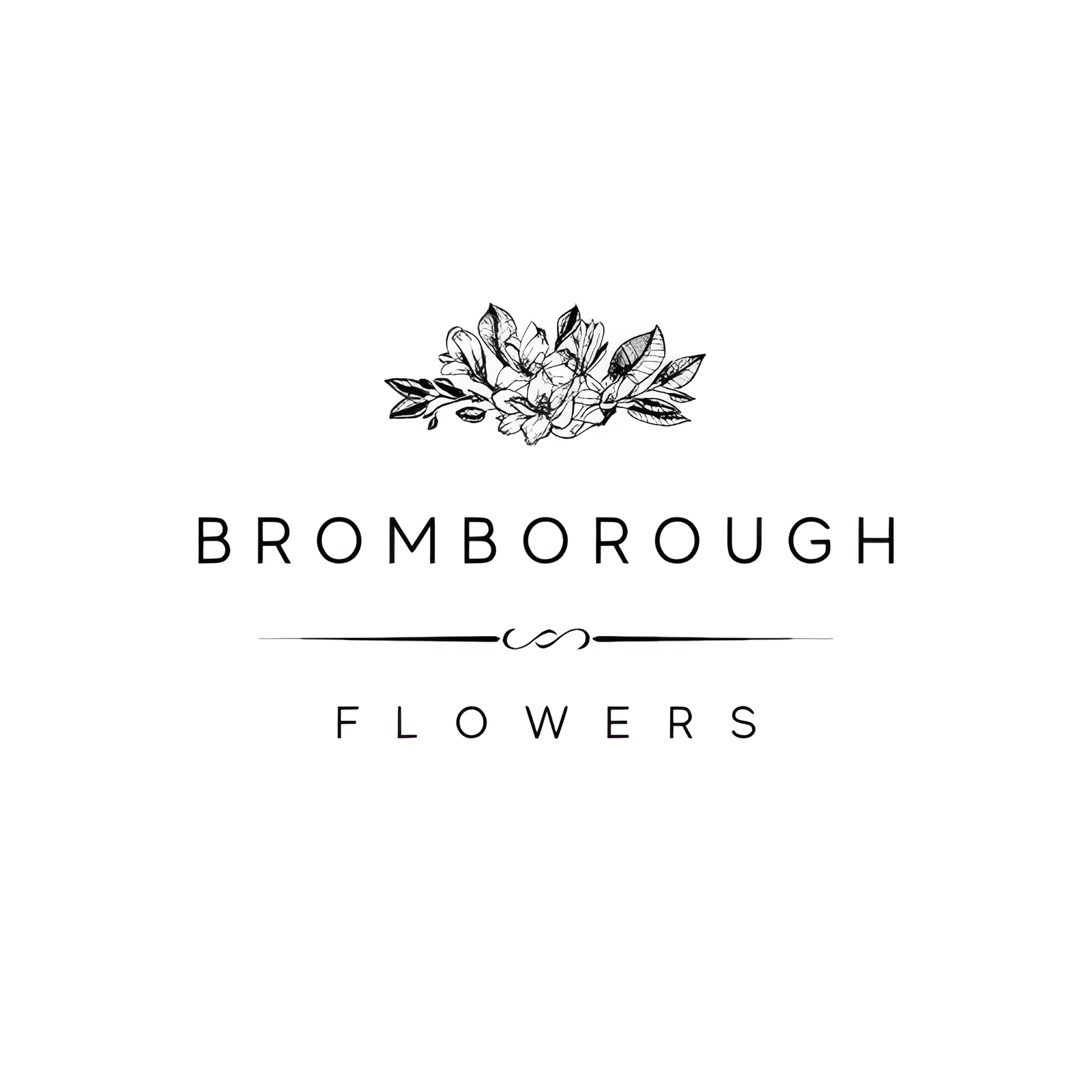Nigella, commonly referred to as Love-in-a-mist or Devil in a Blue Dress, offers a unique charm to wedding decor with its delicate petals and intriguing spiky bracts, making it a favored choice among floral designers. Renowned for its vintage appeal and versatility, this flower boasts a range of colors including white, light blue, dark blue, and rose pink, blooming from August to September. Its fern-like foliage and impressive vase life make it ideal for romantic and vintage-themed weddings. But what makes Nigella truly stand out in floral arrangements, and how can it be best utilized for your special day?
Flower Overview
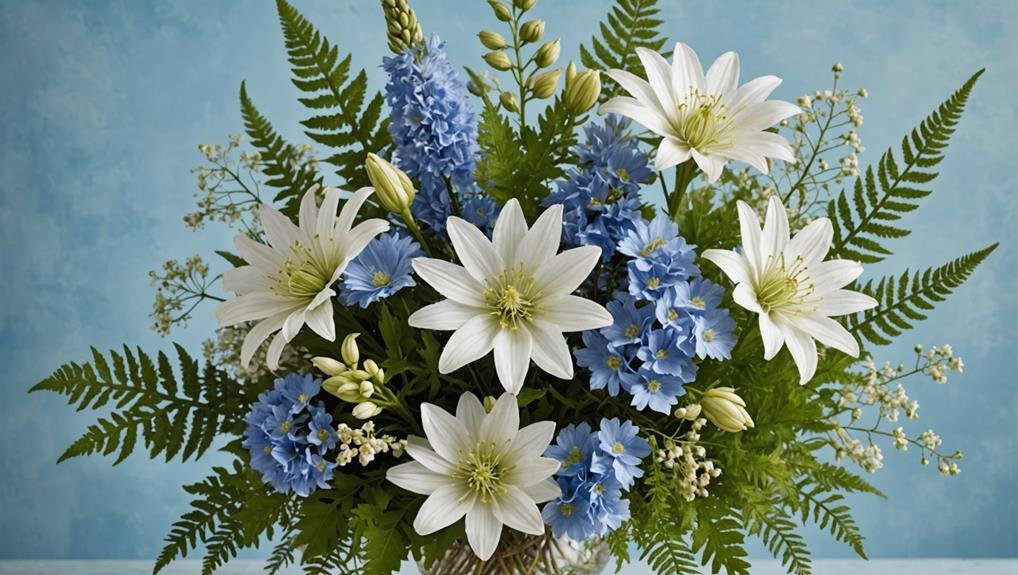
Nigella, commonly known as Love-in-a-mist, is a delicate flowering plant characterized by its fern-like foliage and charming blooms. This versatile cut flower has become a popular choice for wedding decor due to its romantic and whimsical appeal. Ideal for late summer and early fall celebrations, Nigella is available from August to September, aligning perfectly with the seasonal floral needs of many weddings.
One of Nigella's standout features is its long vase life, which ranges from 7 to 10 days. This characteristic guarantees that floral arrangements maintain their freshness and beauty throughout the event, making Nigella a practical choice for wedding decor. Florists and event planners often incorporate Nigella into various floral elements such as bouquets, boutonnieres, corsages, and centerpieces. This consistency helps create a cohesive and enchanting aesthetic across the entire venue.
The delicate blooms of Nigella add a touch of elegance and charm to any wedding arrangement, enhancing the overall ambiance. As a cut flower, Nigella offers both beauty and durability, making it a reliable and attractive option for couples seeking to create memorable, stunning floral displays on their special day.
Physical Description
Adorned with delicate petals and surrounded by an outer shell of spiky bracts, the Nigella flower boasts a distinctive and intricate structure. This enchanting bloom, also known as Love-in-a-mist, Devil in a Blue Dress, or Persian Jewels, is renowned for its unique appearance which makes it a popular choice for wedding arrangements.
The Nigella flower features soft, fern-like foliage that enhances its overall ethereal appeal. Each bloom is composed of multiple layers of petals, which are often finely textured, creating a mesmerizing visual effect. The outer bracts are spiky and form a protective casing around the flower, adding an element of contrast to the delicate inner petals. This combination of softness and structure lends Nigella flowers an almost otherworldly charm.
Nigella damascena, the variety most commonly used in weddings, exhibits these characteristic traits prominently. Typically blooming from August to September, Nigella flowers add a whimsical and romantic touch to floral arrangements.
Their intricate physical description, coupled with their historical and cultural significance, ensures that they remain a favored option for couples seeking distinctive and memorable wedding florals. The delicate beauty and unique structure of Nigella flowers make them a standout choice for any bridal bouquet or centerpiece.
Available Colour Varieties
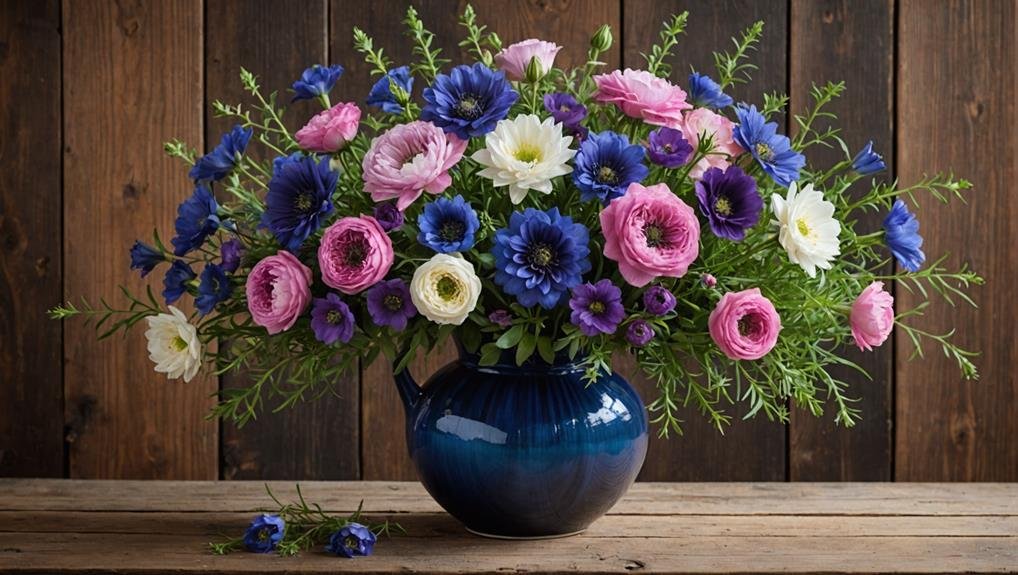
In addition to its intricate structure, the Nigella flower captivates with a variety of color options that enhance its appeal in wedding arrangements. This versatile bloom is available in a spectrum of hues including beautiful white, light blue, dark blue, and rose pink. These color varieties allow florists and event planners to create visually stunning and cohesive floral designs.
One popular variety, the Persian Jewels mixed Nigella, offers a delightful blend of whites, blues, and pinks, making it a versatile choice for vibrant and dynamic arrangements.
Another notable type, Miss Jekyll Love-in-a-Mist, provides light pale blue, dark blue, and beautiful white flowers, offering diverse options for elegant and refined designs.
For those seeking a touch of romance, Nigella Mulberry Rose presents a lovely pink hue, perfect for adding a pop of color to any bouquet.
The wide range of colors available makes Nigella an excellent option for creating depth and interest in wedding bouquets and floral arrangements. Accessible through wholesale flowers suppliers, Nigella's color versatility guarantees it can complement any wedding theme or color scheme, offering endless possibilities for beautiful and memorable floral designs.
Latin Name and Taxonomy
Belonging to the Ranunculaceae family, the botanical name for Nigella is Nigella damascena. This species is well-regarded for its application in wedding arrangements due to its unique and delicate appearance. Understanding the latin name and taxonomy of Nigella damascena is essential for florists and wedding planners who wish to incorporate this charming flower into their designs.
Nigella damascena is characterized by its intricate, fern-like foliage and striking blooms, making it a popular choice for vintage-style weddings. The plant is commonly referred to by various names, including Love-in-a-mist and Devil in a Blue Dress, reflecting its enchanting and somewhat mysterious appearance.
Key points about Nigella damascena's latin name and taxonomy include:
- Family: Ranunculaceae
- Genus: Nigella
- Species: Nigella damascena
- Common Names: Love-in-a-mist, Devil in a Blue Dress
- Usage: Often favored in wedding arrangements for its whimsical charm
The taxonomic classification of Nigella damascena places it within the Ranunculaceae family, a diverse group of flowering plants known for their ornamental and culinary uses. By understanding its taxonomy, professionals can better appreciate the unique characteristics and applications of this exquisite flower in various wedding themes and settings.
Geographical Origins
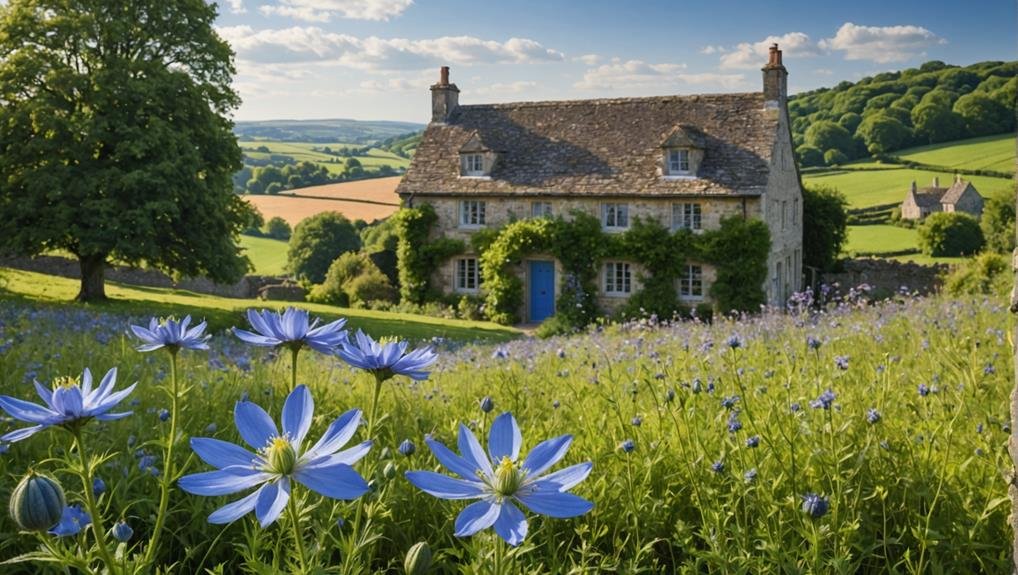
Nigella, commonly known as Love-in-a-mist, originates from the regions of North Africa and Southern Europe. This beautiful and delicate flower, scientifically termed Nigella damascena, is a remarkable member of the Ranunculaceae family. Native to North Africa, Nigella has a storied history in the Mediterranean basin, where it has thrived for centuries.
The geographical origins of Nigella are a tribute to its adaptability. In its native habitats, the plant has evolved to flourish in both the temperate climates of Southern Europe and the more arid conditions of North Africa. This adaptability allows Nigella damascena to grow in a variety of conditions, making it a versatile option for gardeners and florists alike.
Despite its origins, Nigella has spread beyond its native regions, finding favor in gardens and floral arrangements worldwide. Its ability to tolerate cooler weather and thrive in mild climates has contributed to its global popularity. The charming appearance of Nigella flowers, coupled with their historical and geographical significance, makes them an enchanting choice for wedding decor.
Understanding the geographical origins of Nigella enriches our appreciation of this plant, highlighting its versatility and enduring appeal in various cultural contexts.
Season Availability
Typically blooming from August to September, Nigella flowers are a seasonal delight for late summer weddings. Their brief period of availability makes them a cherished choice for couples looking to capture the transient beauty of these months.
Due to their delicate nature and fern-like foliage surrounded by spiky bracts, Nigella flowers add a unique texture and charm to wedding arrangements.
For those planning weddings outside of Nigella's prime season, alternatives such as Blue Thistle or Scabiosa can be considered to achieve a similar aesthetic. The key to maximizing the beauty of Nigella flowers is to start designing with them around two days before the wedding event. This ensures peak freshness and longevity.
Advantages of using Nigella flowers during their season availability include:
- Unique Aesthetic: Delicate blooms with distinctive foliage.
- Long Vase Life: Lasts 7-10 days, perfect for extended celebrations.
- Seasonal Charm: Captures the essence of late summer.
- Versatility: Complements various wedding themes and color palettes.
- Availability of Alternatives: Blue Thistle or Scabiosa can be used when Nigella is out of season.
Incorporating Nigella into your wedding flowers during their specific season adds a touch of natural elegance and fleeting beauty that is bound to be remembered.
Growing Conditions
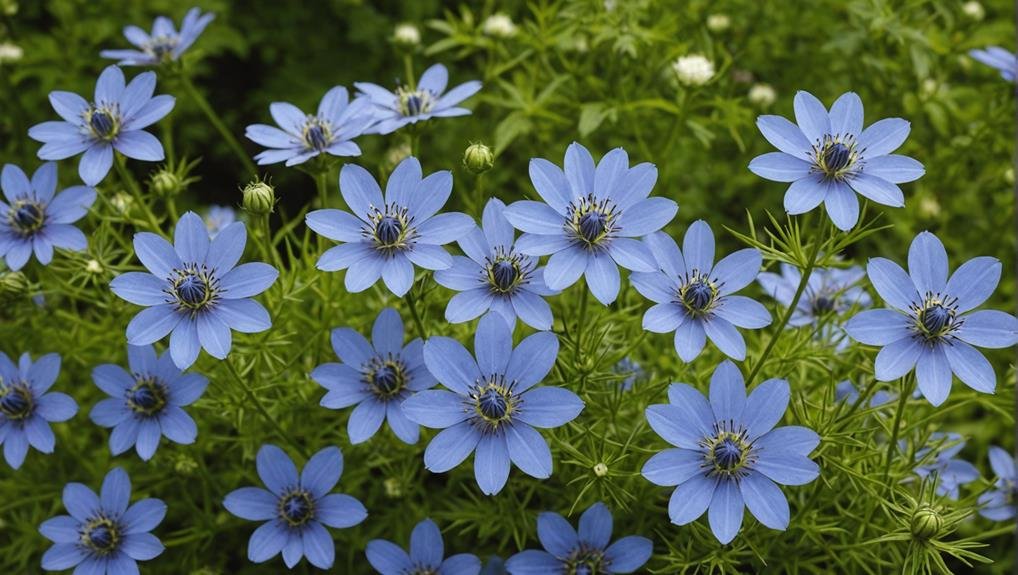
Understanding the ideal growing conditions for Nigella is vital to guaranteeing their vibrant presence in wedding arrangements. Nigella thrives in cooler weather, making it a versatile choice for various climates. Planting Nigella seeds in well-draining soil is necessary, as these flowers prefer not to sit in waterlogged conditions. To ensure continuous blooming, succession sewing from autumn to summer is recommended. This practice allows for a steady supply of fresh Nigella blossoms, perfect for wedding floral designs.
When transplanting Nigella, it is important to avoid disturbing the roots. This promotes healthy growth and aids in developing stronger plants. In periods of dry soil, regular watering is required to encourage longer stem length, which is particularly beneficial for creating elegant floral arrangements. However, overwatering should be avoided to prevent root rot.
To provide additional support, especially in windy conditions, using stakes and netting can prevent the delicate stems of Nigella from bending or breaking. By adhering to these growing conditions, one can cultivate Nigella that is not only visually stunning but also robust enough to withstand the rigors of wedding preparations.
Cultural Significance
Renowned for its symbolism of love, fidelity, and unity, Nigella holds a cherished place in wedding traditions across various cultures. This delicate bloom, often referred to as 'Love-in-a-mist,' captivates with its ethereal beauty and intricate design, making it a favored choice for romantic and vintage-themed celebrations.
Nigella's cultural significance is steeped in history. During the Victorian era, it was believed to offer protection, and brides included it in their bouquets to ward off evil spirits. Its enchanting presence continues to resonate in modern times, embodying the essence of beauty and enchantment in various ceremonies.
Nigella is a great option for those seeking a wildflower look, adding a touch of whimsy and natural elegance to wedding arrangements. Its unique seed pods and feathery foliage create a timeless appeal that complements a range of wedding styles.
- Symbolizes love, fidelity, and unity
- Victorian-era belief in protective qualities
- Popular in romantic and vintage-themed weddings
- Known as 'Love-in-a-mist' for its mystical allure
- Ideal for wildflower-inspired arrangements
Typical Use in Weddings
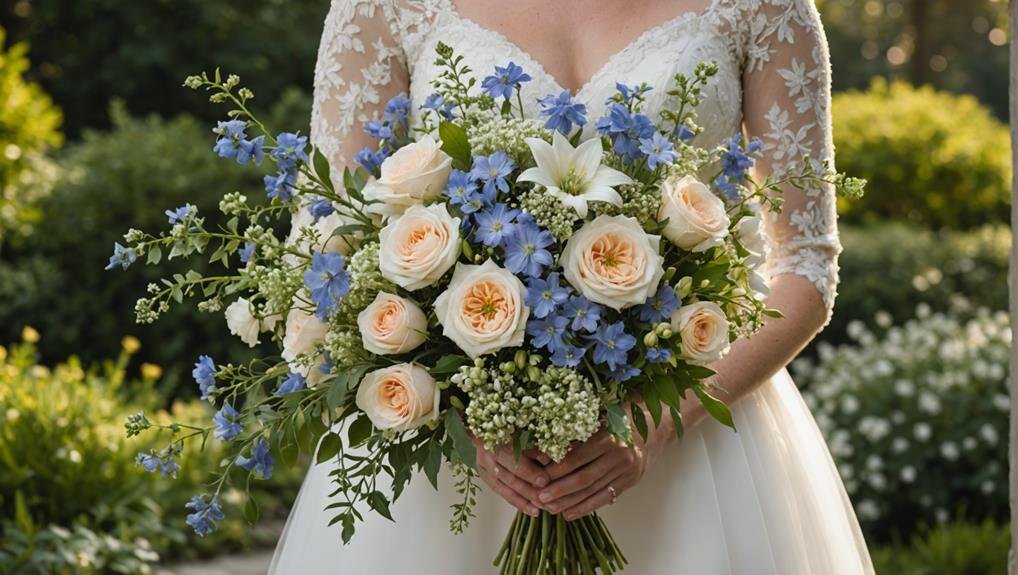
Nigella serves as a versatile element in wedding floral arrangements, appreciated for its delicate, fern-like foliage and unique blooms. This exquisite flower, often referred to as love-in-a-mist, is distinguished by its striking petals surrounded by an outer shell of spiky bracts, making it an appealing choice for various wedding floral designs.
Nigella's charming appearance lends itself well to creating loose, romantic bouquets that blend seamlessly with other mixed blooms. In wedding floral arrangements, Nigella is often paired with classic flowers such as roses and lilies to enhance the overall aesthetic. Its soft, ethereal quality complements these traditional blooms, adding depth and texture without overpowering the arrangement.
Additionally, Nigella is an excellent choice for crafting boutonnieres, corsages, hair crowns, and garlands, providing elegance and a subtle touch of whimsy to wedding decor. Whether used as a focal point or a complementary accent, Nigella's versatility allows it to fit a variety of wedding themes, from rustic to contemporary.
Its ability to stand alone or harmonize with other flowers makes it a valuable addition to any wedding floral arrangement, ensuring a beautiful and memorable presentation.
Alternative Flower Types
When Nigella is out of season, exploring alternative flower types such as Blue Thistle or Scabiosa can provide a similar aesthetic for wedding floral arrangements. These flowers serve as excellent substitutes, offering unique textures and colors that can enhance any bouquet or centerpiece design.
Blue Thistle features a spiky, globe-shaped bloom, perfect for adding texture to your arrangements. Its striking blue hue makes it a standout option for those looking to create a memorable visual impact.
Scabiosa, commonly known as the pincushion flower, offers delicate, rounded blooms available in various colors, from soft pastels to deep purples. This flower's versatility makes it suitable for a wide range of wedding themes and palettes.
Both Blue Thistle and Scabiosa are popular choices for weddings, capable of complementing different floral designs. Here are some key characteristics to explore:
- Blue Thistle:
- Spiky, globe-shaped blooms
- Unique texture
- Striking blue color
- Scabiosa:
- Delicate, rounded blooms
- Variety of colors
- Versatile in design
- Complementary to various themes
- Available outside Nigella's season
Exploring these alternative options can help you create stunning and unique floral arrangements for your special day.
